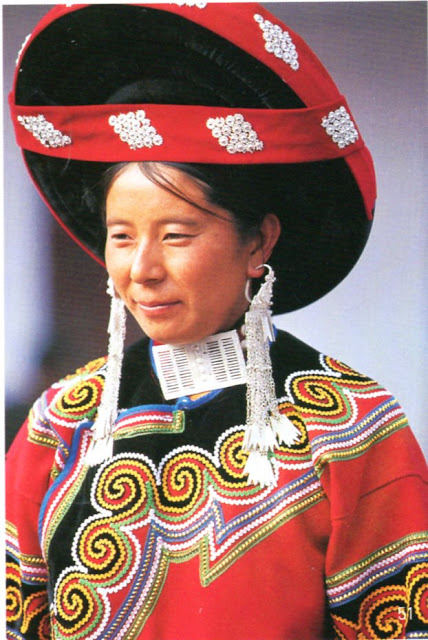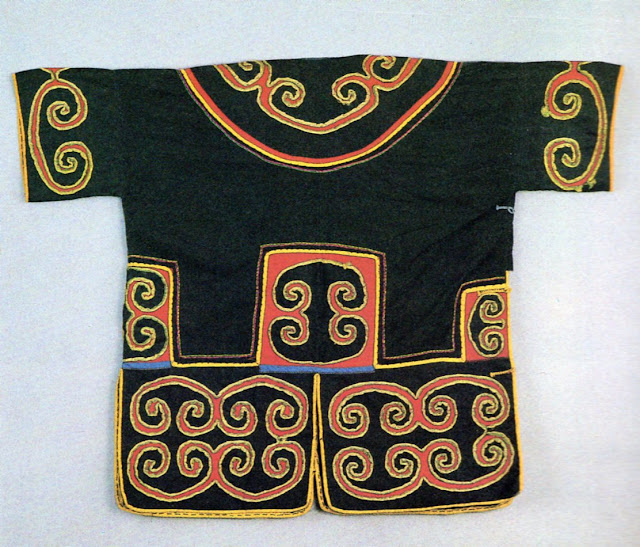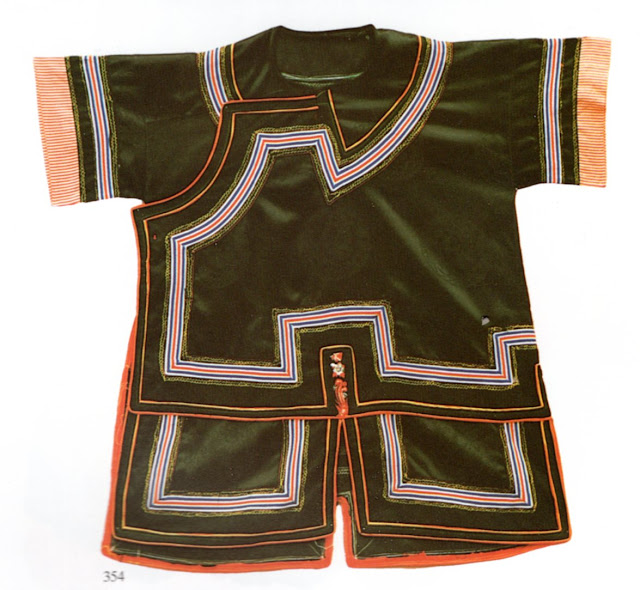Hello all,
Today I will continue my overview of the Sino - Tibetan peoples by talking about the Yi people. The Yi number some 9.5 million people who speak a large number of related languages in the Yi language family. They were formerly called the Lolo. They revere the tiger, and have an especial devotion to the element of fire. They live mostly in Yunnan, southern Sichuan, and western Guizhou Provinces. A few are also found in western Guangxi, as well as northeastern Laos and northwestern Vietnam, where they are still referred to as Lolo. They live mostly in mountainous areas, as do most of the ethnic minorities. When first conquered by the Chinese, they had a very structured and stratified society, with levels from aristocracy down to slaves. The aristocratic Yi believe that they are distinguished from others by having black bones.
https://en.wikipedia.org/wiki/Yi_people
Here is a map showing the distribution of Yi villages in China. Yunnan is in the middle, Sichuan to the north, Guizhou to the northeast, Guangxi to the southeast, and Laos and Vietnam to the south.
You can see that there are several nodes of population. The Chinese government has taken the various Yi tribes and languages and grouped them into 6 officially recognized cultural/linguistic groups.
Yi costumes are usually rich in ornamentation, including applique, reverse applique, 'plain embroidery', by which the Chinese mean satin stitch, and also counted thread embroidery, including cross stitch. Here is a Yi cross stitched medallion featuring eight guardian tigers.
Nuosu or Northern Yi
This group is also called the Liangshan Yi, or the Sichuan Yi. They are mostly found in Liangshan prefecture in southern Sichuan. Here is a rough map of their distribution. 'Bai Yi' is not an ethnic grouping, but rather a caste.
The image at the head of this article shows various costumes of the Nuosu. There are three large groups as well as several smaller ones that make up the Nuosu. Here is a rough map of their distribution in Sichuan. The Yinuo in red, the Shynra in yellow, and the Suondi and Adur in green. They are also found across the border into Yunnan to some extent.
Yynuo
The Yynuo or Yinuo live in the eastern part of this region, in the county of Meigu and to the east. This is also called the 'wide pants region', because the men's trouser legs are each 1.5 to 2 meters wide.
The men's jackets have a broad band of appliqued ornament across the edge of the front opening, as well as on the sleeves, but not on the lower edge.

The cape Caerwa, is very traditional, and varies from county to county, but generally does not have fringe in this group.

The young man above is wearing a 'hero's belt' across one shoulder which is ornamented with shell.
This kind of shoulder bag is also worn by young men.

Men generally wear turbans with a point sticking out in front, different subgroups have different shaped and directed knots.
The women wear long skirts, with a waistband, a cylindrical middle section, and a wide, heavily gathered bottom section. Yinuo women wear a top with a wide zigzag shaped ornament across the front.

In these images you can see that a triangular shaped bag hangs from the waist. This is a common accessory for Nuosu women.
As you can see, young unmarried women wear a headdress of folded cloth held in place on top of the head by a braid, usually fake. The cloth is not embroidered, and has enough layers to stick straight out. Married women wear hats, most typically the lotus leaf hat, but there are regional variations.
Other styles of upper garment are also worn. This first one is for a young girl.

Brides wear a large headdress of cloth wrapped around a bamboo frame and ornamented with silver. Traditionally the bride is carried to the groom's house by one of her male relatives.
Just a couple more images of Yinuo garments.
Skirts from Leibo province are ornamented with patchwork.
The girl on the right is Yinuo, the woman on the left is Adu.
Shynra and Galo
The Shynra live in Xide county and regions north of that. Their territory lies northwest of the Yinuo. The Han Chinese sometimes call them the Shengzha.This is called the 'medium pants region', because Shynra men wear pants, which while still full, have each leg no more than one meter wide.
The men's shirts are ornamented not only on the front opening and sleeves, but also on the hem.
Sometimes a vest is worn over the jacket.
The cape Caerwa is worn here as well, but it usually has fringes.
In other respects the attire resembles that of the Yynuo.
The women's costume is also similar to that of the Yinuo, except that a right closing vest is worn over the jacket. Here is an image of an unmarried girl on the left, a bride in the center, and a married woman on the right, both helping to put the veil and jewelry on the bride. Note the three types of headdress.
Here is an outfit of a middle aged woman.
And an older woman.
The unmarried girls' headdress is like that of the Yinuo except that it is thinner and embroidered, so that the back of it hangs down behind the head.
A subgroup called the Galo, which live in the northern county of Ganluo, wear a vest with the opening in the center.
Married women wear a large hat with a cloth folded and pinned over it.
A third headdress is used for festive occasions, including weddings, especially in the counties of Jinyang,
and Zhaojue.
Here are some more images of the Shynra.
This subgroup group is called the Shama, from Jinyang county.
Suondi and Adu
These groups live in the southwest of this region, in the county of Butuo and to the west and south. This is also called the 'narrow pants region' because the men wear pants that are of usual dimensions. They also wear jackets with minimal ornament except for silver buttons and loops on the side. This man is wearing a Caerwa made of the skins of 5 goats.
The women's costume is similar to that of the other Nuosu, but they wear a vest with short sleeves which is highly ornamented over the jacket, which is often longer. Sometimes the skirts have more complex patchwork designs.
You can see that thes girl is wearing a headdress that somewhat resemblea those of the Shynra.
Large appliqued spiral designs are typical.
Married women wear a vertical headdress that is shaped somewhat like an envelope placed over a vertical support.
Women who are older and have children, sometimes wear a headdress which consists of a turban wrapped around a bamboo frame, especially for festive occasions, when it may be ornamented with jewelry.
Here is an image of a bride and her two attendants.
The women is this group wear heavy short mantles with vestigial sleeves.
For ordinary occasions they often wear simple hats instead of traditional headwear, or just cloths on the head.
These mantles can be very plain, black or natural colored, but some show surprisingly modern looking abstract designs.
For festivals, they carry yellow umbrellas and wear highly ornamented outfits, with jewelry on the large bamboo framed turbans or vertical headdresses. They have a tradition of processional singing, walking in single file, each woman holding the tasseled triangular bag which hangs from the waist of the woman in front.
Just a few more images of this group.
This girl is wearing a hat made of felted yak wool.
Here are a couple of videos about the Nuosu.
This first one is in two parts and shows various traditions of these people. The picture quality is not good, but it is interesting and features native singing.
This one shows scenes from life among the Nuosu. It is overdubbed with music, with subtitles in Nuosu, Italian, and English. It features bullfighting, which is very popular in southeast Asia, but here the bulls fight each other.
This is a video showing Nuosu dances in rather stagy costumes.
Thank you for reading, I hope that you have found this to be interesting and informative.
Roman K
email: rkozakand@aol.com
Source Material:
Unknown Author, 'The Costumes and Adornments of Chinese Yi Nationality Picture Album', Beijing, 1990
Stevan Harrell et al, 'Mountain Patterns - The Survival of Nuosu Culture in China', Seattle, 2000
Susan Gary Walters, 'A Practical Guide to Everything Nuosu', London, 2015
Deng Qiyao et al, 'The Folk Arts of Yunnan Ethnics', Yunnan, 1993
Unknown Author, 'Ethnic Festivals and Costumes of Sichuan', Sichuan, 2004
Chen Hongguang et al, 'Ethnic Costumes Clothing Decorations from China', Chengdu, Sichuan, 1995
Bernard Formoso, 'Costumes du Yunnan', Nanterre, 2013
Shan Ren et al, 'The Cream of Yunling - A Photo Odyssey of Yunnan Ethnic Groups', Kunming, 1998


























































































































I see you have used one of my photographs without authorization. On this occasion I will not require its removal as I found your article informative and yours is not a commercial site. Next time, ask permission first.
ReplyDeleteI thank you for your permission. If you would indicate which photographs are yours I will make proper reference to that fact.
DeleteUnder "Here are some more images of the Shynra." 2nd photo with a clear watermark. All my photographs are copyrighted and prior permission is required for usage.
ReplyDelete